
Mother Tongue (2023)
Dir. Glenn Fraser. Written by Amelia Foxton
Starring Amelia Foxton, Chiara Gizzi, and Stephen Hunter
Director of Photography: Tom Gleeson
Running time: 36 mins
Horror and humour achieve embryonic fusion in Australian director Glenn Fraser’s latest short film, Mother Tongue, written with wit and energy by Amelia Foxton. Alex (Chiara Gizzi) and Jade (Foxton) know all about parenthood from their hetero friends, who visit them only to sit slumped, exhausted—seemingly exsanguinated—by the ordeal. But this cutely clucky same-sex couple aren’t so easily put off. After repeated and steamily determined attempts at impregnation, however, they still don’t have a baby bump between them. Adoption holds no help, as the couple finds its woes compounded by process thick with prejudice.
They explore alternative options, but just how ‘alternative’ will they get? Enter Brian (Stephen Hunter), the black magic sorcerer who promises he can conjure these two a kid. He’s also a try-hard deadshit operating out of an unassuming beige-brick flat. From here, Alex and Jade find themselves entangled in the increasingly wacky world of the suburban occult because, surprise surprise, Brian may be less useless than he appears. Maybe this will work after all? However, we know from the film’s opening—from Jade and Alex’s friends—how enslaved parents are to their infant overlords, and there may be even greater sacrifices in store for this couple.
Fraser and Foxton’s film pulses along through its inspired and knowing embrace of horror tropes—here delightfully embedded in everyday domesticity. Involving and often very fun performances draw much richness from the full veins of Foxton’s script and, despite the film’s short running time, its characters are vividly drawn, with Alex the more reactive and intense of the duo, alongside the more patient and protective Jade, who finally accepts her partner’s pleas to explore every last option. The film also looks splendid, easily immersing us in atmospheres by turns erotic, alarming, and absurd. Parenthood sure seems draining, but you’ll be tickled and fulfilled by Mother Tongue.


 I’m happy to announce that my book
I’m happy to announce that my book 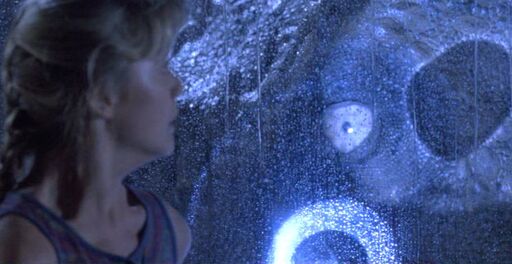
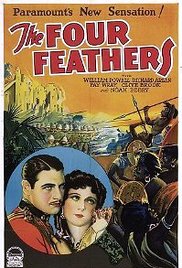
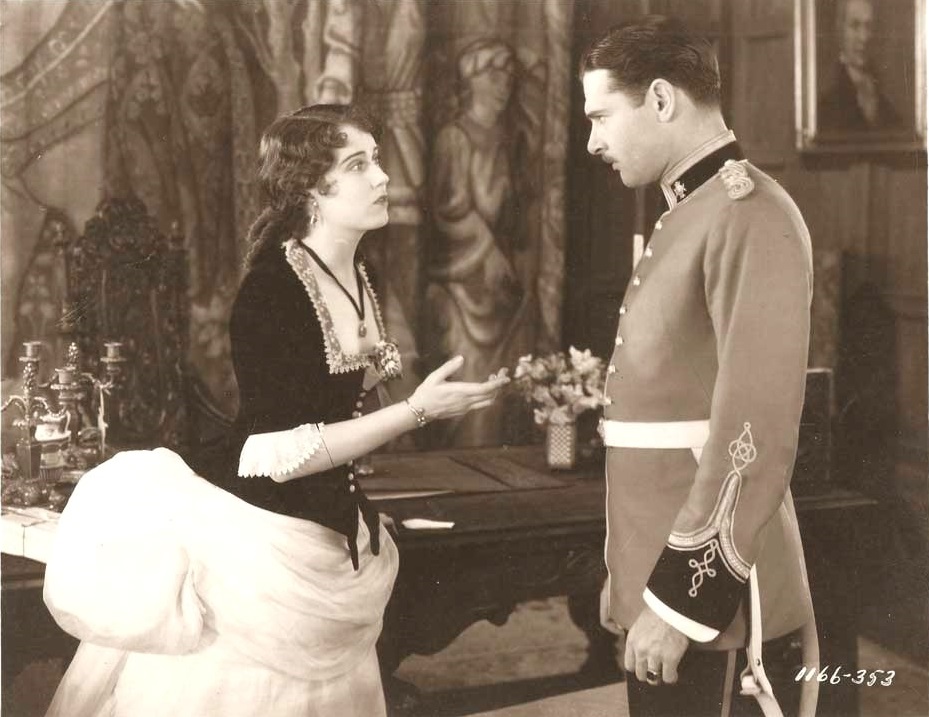
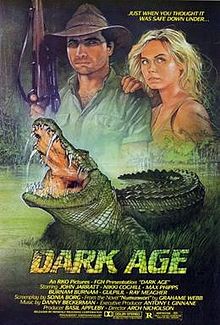 Crocodilian chaos in Australia’s Northern Territory: When one particularly big brute starts snacking on humans, it’s up to wildlife ranger and conservationist Steve Harris (John Jarratt) to bring it to heel. With a sensible respect for the local wildlife, Steve wants to stop the killer croc while preventing a crew of mad hunters (eager for an excuse to indulge their bloodlust) from hitting the creeks for a pump-action killathon.
Crocodilian chaos in Australia’s Northern Territory: When one particularly big brute starts snacking on humans, it’s up to wildlife ranger and conservationist Steve Harris (John Jarratt) to bring it to heel. With a sensible respect for the local wildlife, Steve wants to stop the killer croc while preventing a crew of mad hunters (eager for an excuse to indulge their bloodlust) from hitting the creeks for a pump-action killathon.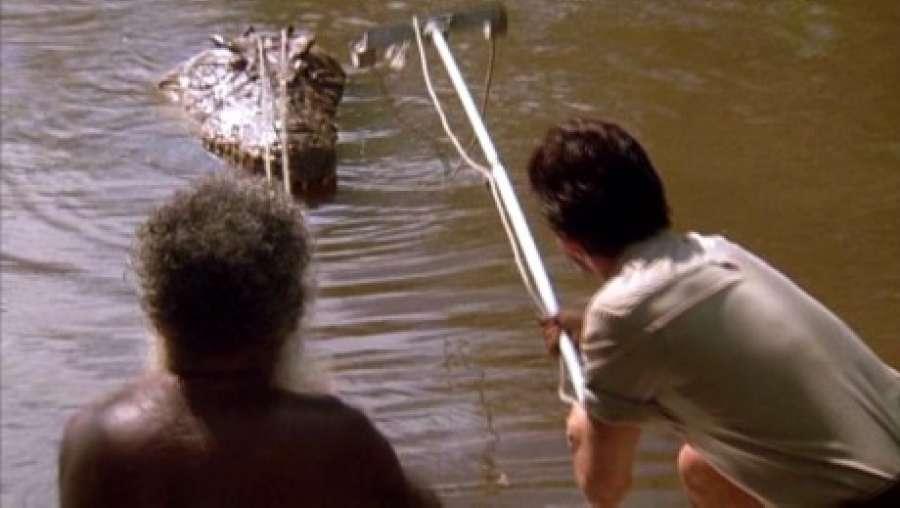 Ultimately, Dark Age depicts an outback culture whose powerful players are in hot pursuit of modernization and money, trying to leave behind an indigenous history—and present—to which the creature is connected. The subtext comes on a little strong at one or two points, but amid numerous less imaginative Jaws-imitators it’s refreshing to see a film so brimming with ideas.
Ultimately, Dark Age depicts an outback culture whose powerful players are in hot pursuit of modernization and money, trying to leave behind an indigenous history—and present—to which the creature is connected. The subtext comes on a little strong at one or two points, but amid numerous less imaginative Jaws-imitators it’s refreshing to see a film so brimming with ideas.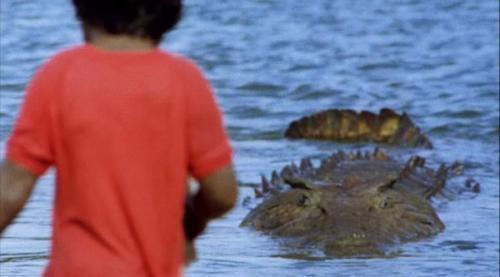 The film’s score, heavy on the synth drums, is at times distractingly dated, and can’t always summon the intensity required (especially during a Jaws-like pursuit of the predator). The crocodile effects are also limited and sometimes log-like: one shot of the croc on the water’s surface seems to terminate because the model is slowly drifting off to the left. Shots of the brute in motion could have been livened up with some strategically edited and inserted stock footage. That aside, the film invests properly in its human drama, and tensions within the town (and culture more broadly) are played out through strong performances. As implied above, though, the film is perhaps most effective in its evocation of Australia as a kind of haunted land: a place with an ancient identity of which its white inhabitants are ignorant, but which nevertheless bursts violently forth from the past—and bites. 3.5 / 5
The film’s score, heavy on the synth drums, is at times distractingly dated, and can’t always summon the intensity required (especially during a Jaws-like pursuit of the predator). The crocodile effects are also limited and sometimes log-like: one shot of the croc on the water’s surface seems to terminate because the model is slowly drifting off to the left. Shots of the brute in motion could have been livened up with some strategically edited and inserted stock footage. That aside, the film invests properly in its human drama, and tensions within the town (and culture more broadly) are played out through strong performances. As implied above, though, the film is perhaps most effective in its evocation of Australia as a kind of haunted land: a place with an ancient identity of which its white inhabitants are ignorant, but which nevertheless bursts violently forth from the past—and bites. 3.5 / 5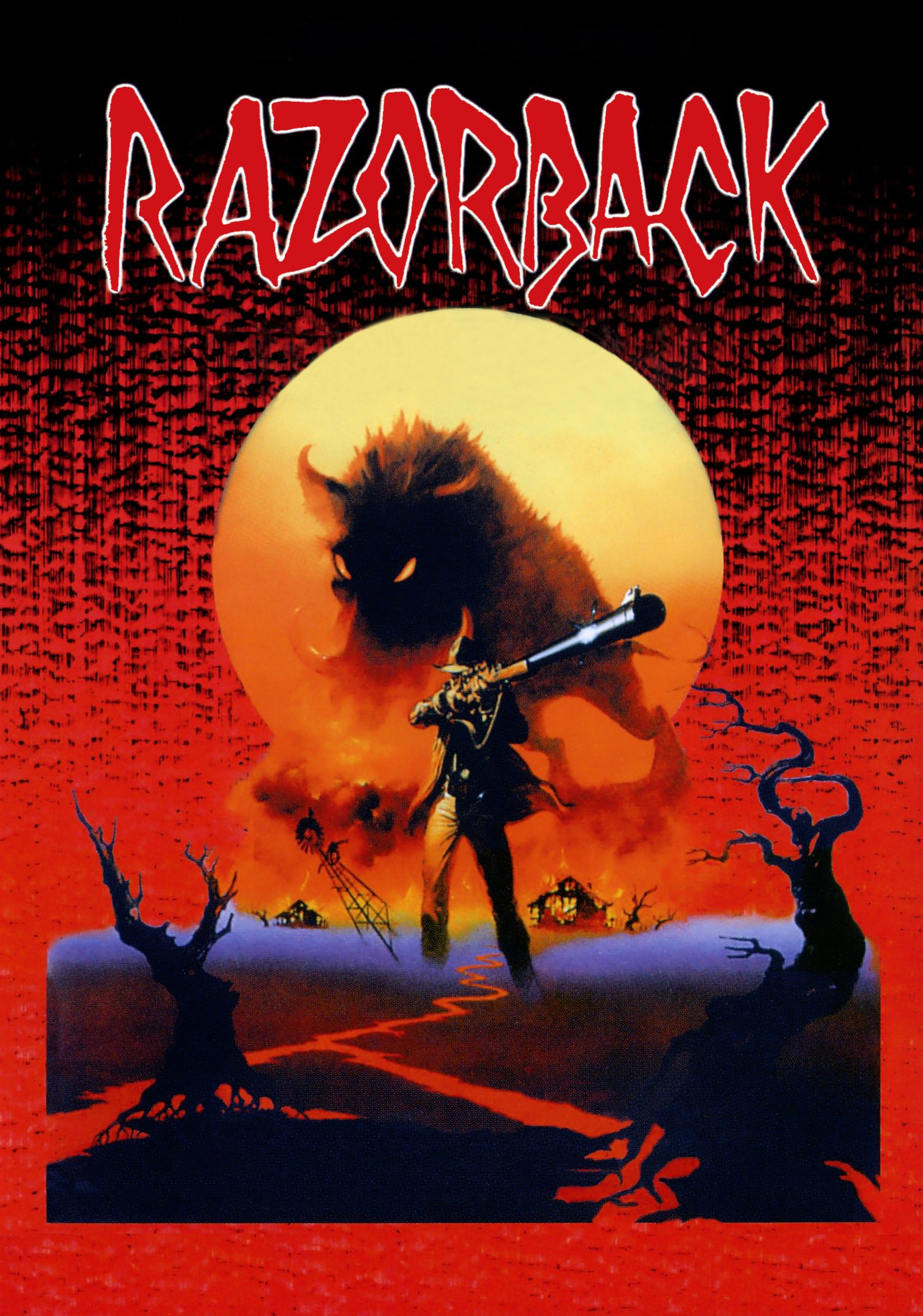 RAZORBACK (1984)
RAZORBACK (1984)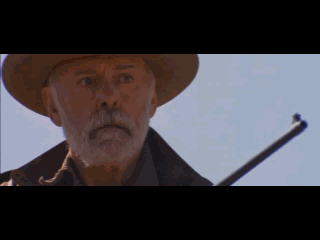 Meanwhile, grizzled pig-shooter Jake (Bill Kerr), grandfather of the stolen baby, begins a Quint-like quest against the beast. Regrettably, Jake is but a shadow of his animal-horror influences, and the film suffers here from its indecisive tone: it’s hard to develop a scarred and serious character in a circus like this. Leaving that aside, Razorback is stylish and garishly striking—fairly well-financed but shot with an irresistible exploitation verve. The final showdown with the big boy (with much organ-pounding over the soundtrack) is sort of scarier than the rest of it, but foremost a silly delight. 3.5 / 5
Meanwhile, grizzled pig-shooter Jake (Bill Kerr), grandfather of the stolen baby, begins a Quint-like quest against the beast. Regrettably, Jake is but a shadow of his animal-horror influences, and the film suffers here from its indecisive tone: it’s hard to develop a scarred and serious character in a circus like this. Leaving that aside, Razorback is stylish and garishly striking—fairly well-financed but shot with an irresistible exploitation verve. The final showdown with the big boy (with much organ-pounding over the soundtrack) is sort of scarier than the rest of it, but foremost a silly delight. 3.5 / 5 An intense and aggressive domestic drama descends into experimental horror in Żuławski’s cult classic Possession. Steered visually by the restless cinematography of Bruno Nuytten the film constructs a world pervaded by uncertainty, discomfort, and a sense of worse to come. The initial horror is of an everyday nature: Mark (Sam Neill) arrives home to Berlin to discover his wife Anna (Isabelle Adjani) has been having an affair and is not the least bit sorry about it either. He turns on the insecure male hysterics and quickly drives her to a similar pitch—then beyond. However, in an apartment downtown Anna has been keeping (and gradually growing) a more monstrous secret, and as her behavior becomes more and more unhinged the film explodes into a warped and chaotic exploration of loathing, desire, and frustration.
An intense and aggressive domestic drama descends into experimental horror in Żuławski’s cult classic Possession. Steered visually by the restless cinematography of Bruno Nuytten the film constructs a world pervaded by uncertainty, discomfort, and a sense of worse to come. The initial horror is of an everyday nature: Mark (Sam Neill) arrives home to Berlin to discover his wife Anna (Isabelle Adjani) has been having an affair and is not the least bit sorry about it either. He turns on the insecure male hysterics and quickly drives her to a similar pitch—then beyond. However, in an apartment downtown Anna has been keeping (and gradually growing) a more monstrous secret, and as her behavior becomes more and more unhinged the film explodes into a warped and chaotic exploration of loathing, desire, and frustration.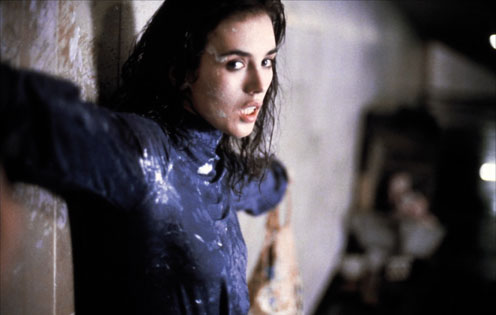 possible identification or sympathy, risking a kind of objectifying ‘insanity porn’—a display foremost for our shock and amazement. Or perhaps in its transgressive and apocalyptic intensity (far beyond narrative or meaning) the moment achieves a kind of liberatory chaos? I expect opinions vary.
possible identification or sympathy, risking a kind of objectifying ‘insanity porn’—a display foremost for our shock and amazement. Or perhaps in its transgressive and apocalyptic intensity (far beyond narrative or meaning) the moment achieves a kind of liberatory chaos? I expect opinions vary.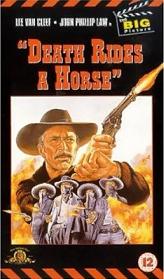 Good old-fashioned revenge doesn’t get much better than this down and dirty lead crusade from Giulio Petroni. On the kind of sodden night from which nothing good can come a gang of hoods storm the home of the young Bill Meceita, murdering both his parents. 15 years later, all grown up and more than handy with a gun, Bill (John Phillip Law) sets out for revenge. Meanwhile, Ryan (Lee Van Cleef), an outlaw as weathered as the rocks he splits during his term of hard labor, is finally granted release and begins his pursuit of the crooks who double-crossed him into the slammer in the first place. You guessed it: they’re the same low-lives.
Good old-fashioned revenge doesn’t get much better than this down and dirty lead crusade from Giulio Petroni. On the kind of sodden night from which nothing good can come a gang of hoods storm the home of the young Bill Meceita, murdering both his parents. 15 years later, all grown up and more than handy with a gun, Bill (John Phillip Law) sets out for revenge. Meanwhile, Ryan (Lee Van Cleef), an outlaw as weathered as the rocks he splits during his term of hard labor, is finally granted release and begins his pursuit of the crooks who double-crossed him into the slammer in the first place. You guessed it: they’re the same low-lives.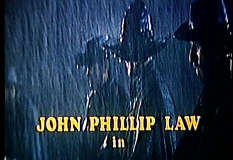 Although the film’s main interest is action—the simple pleasure of watching a couple of tough hombres take care of business—Petroni’s stylistic flair lends a symbolism of its own to these proceedings. The treachery and isolation of the Western landscape, the inexorability of fate, and the development of a surrogate father/son relationship between Ryan and Bill are all evoked.
Although the film’s main interest is action—the simple pleasure of watching a couple of tough hombres take care of business—Petroni’s stylistic flair lends a symbolism of its own to these proceedings. The treachery and isolation of the Western landscape, the inexorability of fate, and the development of a surrogate father/son relationship between Ryan and Bill are all evoked.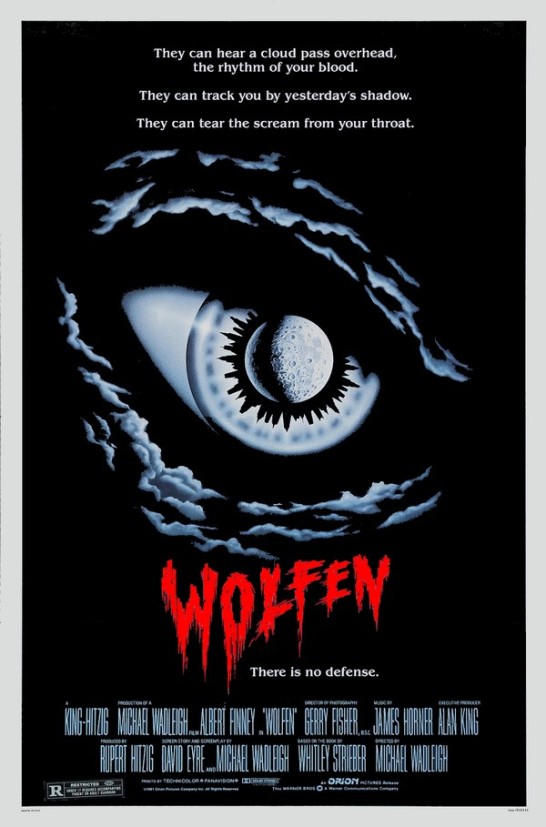 WOLFEN (1981)
WOLFEN (1981) This theme is hauntingly imbued in images of industrial and residential dilapidation—urban rubble through which the wolves stalk their prey. As Wilson tracks his targets, a tingling, stealthy score by James Horner accents (and never smothers) the film’s shivery atmosphere. A film as dark, graceful and bewitching as its elusive antagonists. 5 / 5
This theme is hauntingly imbued in images of industrial and residential dilapidation—urban rubble through which the wolves stalk their prey. As Wilson tracks his targets, a tingling, stealthy score by James Horner accents (and never smothers) the film’s shivery atmosphere. A film as dark, graceful and bewitching as its elusive antagonists. 5 / 5